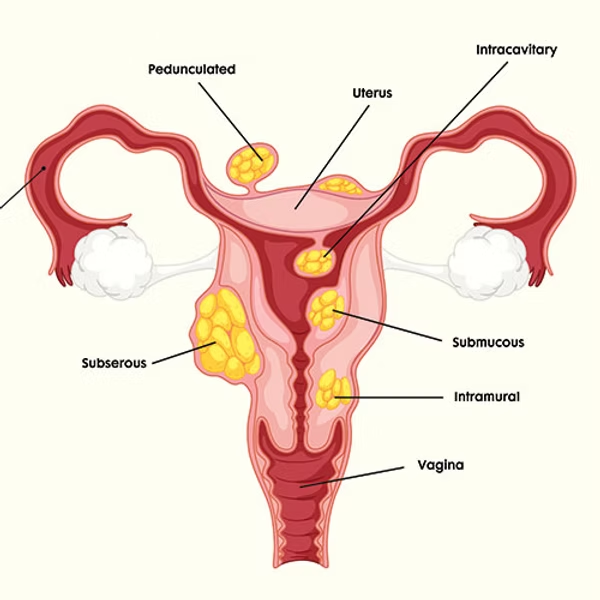
These tumors, although typically benign, can cause a wide range of symptoms and health issues, especially in women of reproductive age. In this article, we at Patteds Fertility and Research Centre aim to provide a detailed understanding of fibroids, their causes, symptoms, diagnosis, and treatment options, as well as how they can impact fertility.
Understanding Fibroids: What Are They?
Fibroids are muscular tumors that form in the wall of the uterus. While most fibroids do not cause symptoms and may go unnoticed, some can lead to significant health concerns. Classified into different types depending on their location within the uterus:
-
Intramural Fibroids: These are the most common type and grow within the muscular wall of the uterus.
-
Subserosal Fibroids: These fibroids develop on the outer surface of the uterus and can become quite large.
-
Submucosal Fibroids: These grow just beneath the inner lining of the uterus and may affect the uterine cavity.
-
Cervical Fibroids: Located in the cervix, these fibroids are less common but can still cause significant issues
Fibroids are typically diagnosed in women between the ages of 30 and 50 and can vary in number, with some women developing just one fibroid, while others may have several.
Causes of Fibroids
The exact cause of fibroids remains unclear, but several factors may contribute to their development:
-
Hormonal Imbalances: Estrogen and progesterone, two key hormones involved in the female reproductive cycle, are believed to play a significant role in the growth of fibroids. These hormones stimulate the growth of fibroid cells, which is why fibroids tend to shrink after menopause when hormone levels decrease.
-
Genetic Factors: There may be a genetic predisposition to developing fibroids. Women with a family history of fibroids are more likely to develop them themselves.
-
Age and Ethnicity: Fibroids are most common in women of reproductive age, particularly those in their 30s and 40s. Studies also show that African-American women are more likely to develop fibroids at a younger age and may experience more severe symptoms compared to women of other ethnicities.
-
Other Factors: Obesity, high blood pressure, and certain lifestyle factors, such as a diet rich in red meat or low in green vegetables, may increase the risk of developing fibroids.
Symptoms of Fibroids
While many women with fibroids may have no symptoms at all, others may experience a variety of discomforts. The severity of symptoms depends on the size, location, and number of fibroids. Common symptoms of fibroids include:
-
Heavy Menstrual Bleeding: Women with fibroids often experience heavy, prolonged periods, which can lead to anemia.
-
Pelvic Pain or Pressure: Large fibroids can cause significant pressure or pain in the pelvic area, which may affect daily activities.
-
Frequent Urination: Fibroids pressing on the bladder can cause frequent urination or difficulty emptying the bladder.
-
Back or Leg Pain: In some cases, fibroids can press on the nerves of the back or legs, leading to pain or discomfort.
-
Pain During Intercourse: Some women with fibroids experience pain or discomfort during sexual intercourse, especially if the fibroid is located near the cervix.
In some cases, fibroids may cause infertility or recurrent miscarriages, which is why it’s important for women struggling to conceive to seek proper medical advice.
Diagnosing Fibroids
Patteds Fertility and Research Centre, we use advanced diagnostic tools to accurately detect and assess fibroids. Common diagnostic procedures include:
-
Pelvic Exam: During a routine pelvic exam, your doctor may feel for abnormalities in the size or shape of the uterus, which could indicate the presence of fibroids.
-
Ultrasound: This is the most common imaging technique used to identify fibroids. A pelvic or transvaginal ultrasound can provide detailed images of the uterus and detect fibroids.
-
MRI (Magnetic Resonance Imaging): An MRI may be used to get more detailed images of fibroids, especially if the diagnosis is unclear or if the fibroids are large.
-
Hysteroscopy: In some cases, a hysteroscope (a thin, flexible tube) may be inserted into the uterus through the cervix to directly view the fibroids.
Treatment for fibroids depends on the size, location, and symptoms of the growths, as well as whether or not the woman is experiencing fertility problems. Options include
-
-
Non-Surgical Procedures: Non-invasive procedures like uterine artery embolization (UAE) or MRI-guided focused ultrasound (MRgFUS) may be used to shrink or destroy fibroids. These options can be effective for women who wish to avoid surgery.
-
Surgical Treatments: In cases where fibroids cause significant symptoms, surgery may be necessary. The two main types of surgery are:
-
Myomectomy: A procedure to remove fibroids while preserving the uterus, often recommended for women who wish to retain fertility.
-
Hysterectomy: The complete removal of the uterus, usually performed in cases where fibroids are large or severe and other treatments have failed.
-
Fertility Treatment: For women struggling with infertility due to fibroids, assisted reproductive technologies like in vitro fertilization (IVF) may be considered after fibroids are treated or removed.
How Fibroids Affect Fertility
Fibroids can sometimes interfere with a woman’s ability to conceive, depending on their size, location, and number. Submucosal fibroids, for example, can distort the uterine cavity, making it difficult for an embryo to implant. In addition, fibroids can increase the risk of complications during pregnancy, such as miscarriage, preterm labor, and placental abruption. However, many women with fibroids are able to conceive and have healthy pregnancies with the right treatment and care.